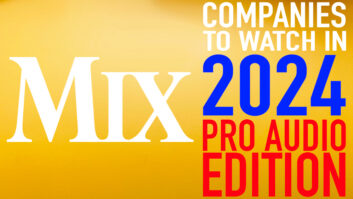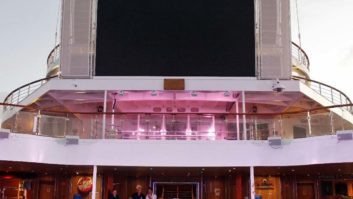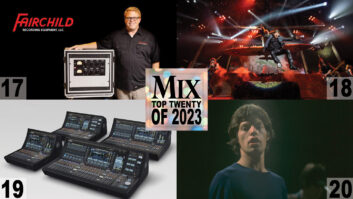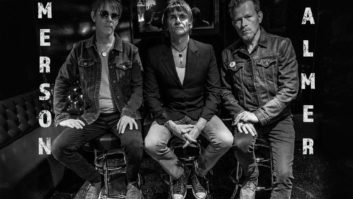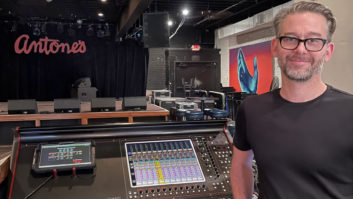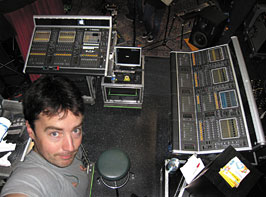
Engineer/author Kevin Madigan on the job on a recent tour with a D5 Live and a D1
DiGiCo’s D1 and D5 Live Series comprise comprehensive, versatile digital consoles with outstanding sonic quality and intuitive operation. They can be found on prestigious productions ranging from Broadway shows to stadium rock tours. Here are a few tips and bits of advice I’ve picked up after mixing on these boards during the past few years.
GOOD HOUSEKEEPING
This is simple but I can’t overemphasize its importance: Save all those changes you make to your mix several times during and then after soundcheck, and be descriptive in how you use names. The project folder could be the name of the city you’re in, and the session file names and description reflect when they were done. Later, when you’re searching for something, a logical file-naming system will make your life easier. For example, Project folder: ny; file name: sndchk1.ses; description: RadioCity FOH. It’s also a good idea to keep a regularly updated copy of your commonly used sessions, preset files and socket files on a separate USB memory stick.
SESSION SETUP
When I’m setting up my initial session, I always allow for two additional mono and stereo sends than I initially need, if resources allow. The same applies to groups. It’s useful to have a template setup that’s close to what you’ll finally need. It could be an FOH setup with your favorite effects sends and returns already assigned, or a monitors setup with graphic EQs already inserted across the aux sends.
MONEY, MONEY, MONEY
There’s often a “money” channel at a show. If you have a lot of channels to deal with on different banks and want to keep track of the money fader, then copy it to the same fader position in each bank on that input surface and “gang” them together to make sure changes on one are reflected in all. They’ll be automatically included in any control groups already set up for the original channel.
MORE MASTER EQ
Want a parametric and a graphic EQ across your master LR? Here’s how: Insert the graphic as normal over the master. In matrix inputs, choose the master L and R for inputs to matrix 1 and 2, respectively. Send L to matrix 1 output at 0 dB and R to matrix 2 output at 0 dB. Select your output socket via the matrix outputs. Raise matrix 1 and 2 faders to 0 dB. Insert processing channel 1 across matrix 1 output and then insert processing channel 2 across matrix 2 output. Enable the parametric EQ. Raise processing channel 1 and 2 faders to 0 dB and — if desired — gang these channels so that changes are common to both parametrics. You now have a regular LR graphic and a 6-band parametric with which to play.
MADI HAPPY RETURNS
MADI lines offer a convenient way to send returns from the house to monitor boards. To begin, you’ll need three MADI cables: one for MADI signals from the stage rack to FOH, one for word clock (although this is not needed with Version 4 software) and one for the return signals from FOH to monitor world. Next, you’ll need to include a line in the sockets files at FOH and monitors: MADI 3 = 48. This will give you 48 ins and outs on MADI 3. Connect MADI 3 out on the FOH console to MADI 3 in on the monitor console. Now you can output your master L/R at FOH to MADI 3-1 and MADI 3-2, and these can be picked up on the monitor console and routed to processing and amplifiers onstage.
PLUG IT IN
Using plug-ins is easily done on a D1 or D5 — all you’ve got to do is edit your sockets file and have MADI 4 declared as plug-ins 1 through 56. Then, using an RME HDSP MADI card in a PC or Mac lets you connect your DAW. Using the DAW provides access for eight units deep per channel. This allows you to connect up to 56 channels of plug-ins, either directly in your DAW package or as extra VST bundles or third-party cards. The connection is just as simple: just two BNC cables. The plug-ins will appear anywhere they may be required on the console: send/returns, groups, auxes, matrix, etc.
RECORDING
You can easily record up to 112 channels of audio over two MADI lines. Again, all you need is a MADI card (such as RME’s HDSP) in a computer running some DAW software. I use Steinberg Cubase 4, which records in the broadcast WAV format that’s compatible with just about every pro digital editing system. Depending on what recording software you’re using, you can program a macro on the D1/D5 to fire a MIDI patch to start/stop recording.
I recently worked on a project with a recording engineer who wanted a split directly to Pro Tools. At the time, I thought this might be a costly venture requiring a load of extra AES outputs in my stage rack until I heard about SSL’s XLogic Delta Link MADI HD, which, as its name implies, is a MADI-to-Pro Tools HD converter. All I needed was this single-rackspace chassis, SSL’s simple MADI opti-co-ax adapter, two BNC cables to connect to the console and two HD cables for my Pro Tools. This gave me 56 tracks of record and playback. If I want 112, then I just double up — easy.
Kevin Madigan is a touring sound engineer, system tech and sometime acoustic consultant based in Los Angeles and Dublin.



